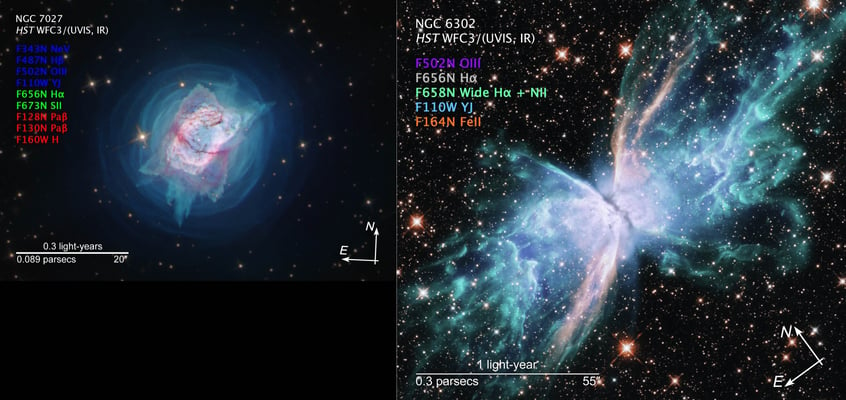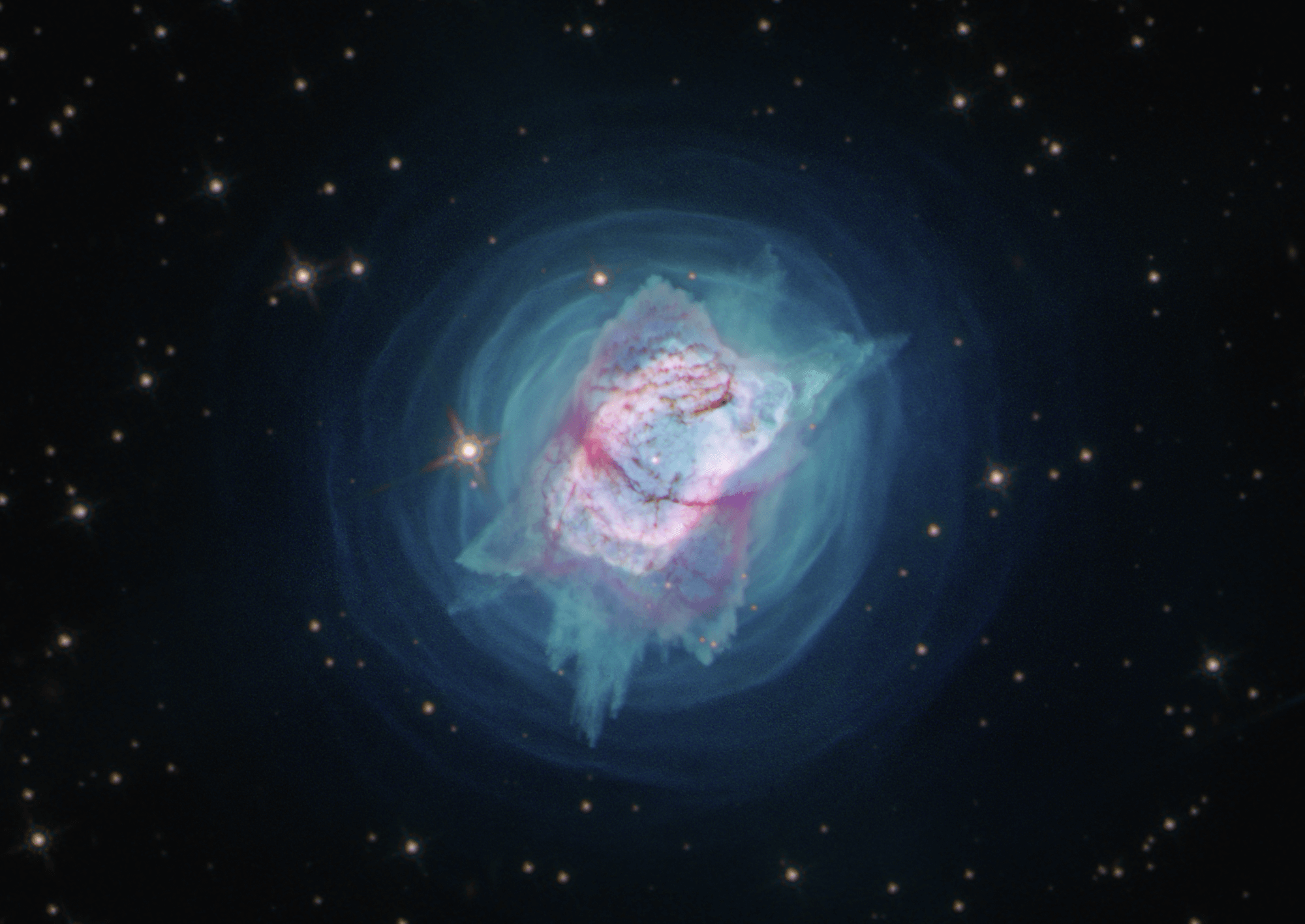Violent Death of Star Captured by Hubble

Compass image of nebula NGC 7027 and NGC 6302. Image credit: Hubblesite
It is believed that stars and planets in the universe originate from the gas and dusty molecular clouds in space by the process of gravitational collapse.
Energy production at the star is similar to that of the nuclear fusion reactor. At the core of main-sequence stars, Hydrogen fusion - a nuclear fusion of four protons to form a Helium-4 nucleus, takes place and the enormous energy is generated. During the process of fusion, heavier elements up to iron will be formed.
Brief Evolution of a Star
The entire process of the evolution of star will take a few billion years.
Once the fuel (Hydrogen) ended, then the star gradually starts to die and eventually fades out. First, the star will contract due to gravity and the resulted imbalance in hydrostatic equilibrium in it. Though Hydrogen at the core has been depleted, some hydrogen fusion still occurs in its upper layers. As the core contracts, it heats up, so the upper layers also heat up and start to expand. This heating and expanding phenomenon increase the radius of the star and the star becomes a red giant. Now at some point, the core will become hot enough to cause the Helium to fuse into carbon, and eventually, Helium will also deplete. When the helium fuel runs out, the core will expand and cool. Now the upper layer of the star will expand and eject material (stellar material) that will collect around the dying star to form a planetary nebula. These are called the planetary nebula because initially in the 18th century these objects were described as planet-like objects. At last, the core of the dying star will cool into a white dwarf and then eventually into a theoretical stellar remnant black dwarf.

Though a typical star will die through the above mention process, the evolution stages entirely depend on the initial mass of the star. It is expected that the Sun will form a planetary nebula at the end of its life cycle.
Earlier in May 2020, astronomers witnessed a star system being born. Though the observation appeared as previously predicted model of the star formation, the observation was utterly a surprising scene and now a team of astronomers using Hubble Space Telescope witnessed a violent death of the star (planetary nebula stage - a stage in the evolution of star).
The research paper describing the study details was published in the journal Galaxies on June 15, 2020.
The team presented a detailed image and a study of two planetary nebulae, NGC 7027 and NGC 6302 (also called the Butterfly Nebula, Bug Nebula) that will be a key source for understanding the process of evolution of stars and also bizarre planetary nebula shaping processes.
This is the first time both nebulas have been studied from near-ultraviolet to near-infrared light, a complex, multi-wavelength view only possible with Hubble.
Hubble telescope is a space-based telescope that is fitted with a 94.5 inches (2.4 m) diameter Aluminum-coated glass mirror and is able to observe a near-ultraviolet, visible and near-infrared spectrum of the electromagnetic spectrum. Note that this does not mean that Hubble can see all three spectrums at once; it can only see each kind of light one at a time.
Joel Kastner of Rochester Institute of Technology, Rochester, New York, leader of the new study said, "When I looked in the Hubble archive and realized no one had observed these nebulas with Hubble's Wide Field Camera 3 across its full wavelength range, I was floored. These new multi-wavelength Hubble observations provide the most comprehensive view to date of both of these spectacular nebulas. As I was downloading the resulting images, I felt like a kid in a candy store."
The team found two S-shaped streams (wings of a butterfly) in the nebula NGC 6302 and this indicates that its most recent ejections may be the result of two stars interacting at the nebula's core. The so-called "wings" like the structure of NGC 6302 are regions of gas heated to more than 36,000 degrees Fahrenheit that is spreading across space at more than 600,000 miles an hour.
Kastner explained, the S-shape in the iron emission from the Butterfly Nebula is a real eye-opener and this S-shape directly traces the most recent ejections from the central region of NGC 6302.

Similarly, a new cloverleaf with bullets of material shooting out in specific directions has been seen in the case of NGC 7027 and this also buttresses the interactions of two central stars. The appearance resembling a colorful jewel bug of NGC 7027 may be the result of ejections by closely orbiting binary stars.

Kastner said, “The nebula NGC 7027 shows emission at an incredibly large number of different wavelengths, each of which highlights not only a specific chemical element in the nebula but also the significant, ongoing changes in its structure.”
Scientists believe that the star or stars at its center are responsible for the nebula’s appearance.
The team suspects that both at the hearts of both nebulas are/were two stars incircling around each other and ejecting the stellar material at last.
Bruce Balick of the University of Washington in Seattle said, "The suspected companion stars in NGC 6302 and NGC 7027 haven't been directly detected because they are next to, or perhaps have already been swallowed by, larger red giant stars, a type of star that is hundreds to thousands of times brighter than the Sun.”
The new, high-resolution images have enabled astronomers to study the shocks generated by periodic stellar winds slamming into the slower-moving dense clouds.
